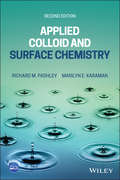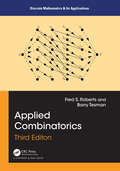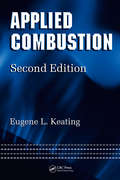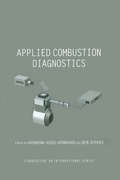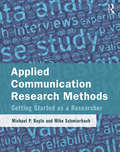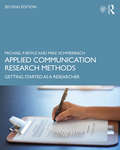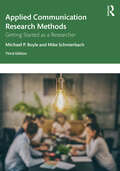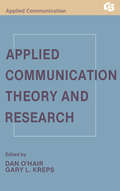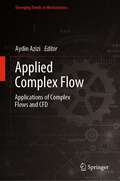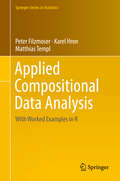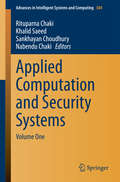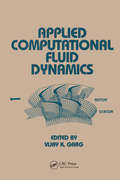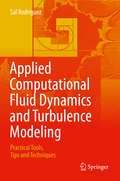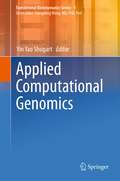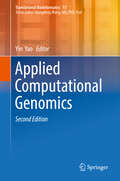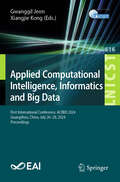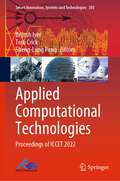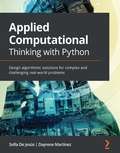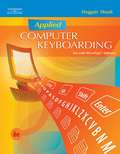- Table View
- List View
Applied Cognitive Task Analysis in Aviation
by Thomas L. Seamster Richard E. ReddingDue to the requirements of automatic system design, and new needs for the training of complex tasks, Cognitive Task Analysis (CTA) has been used with increasing frequency in recent years by the airline industry and air traffic control community. Its power is reflected in the literature on professional training and systems design, where CTA is often cited as one of the most promising new technologies, especially for the complex cognitive tasks now confronting those working in aviation. The objective of this book is to bridge the gap between research and practice, to make what we know about CTA available to practitioners in the field. The book focuses on cognitive psychology and artificial intelligence analyses of aviation tasks. It is designed to help readers identify and solve specific design and training problems, in the flight deck, air traffic control and operations contexts. Distilling experience and guidelines from the best aviation cognitive analyses in accessible form, it is the first comprehensive volume on CTA, and is written for practitioners of cognitive analysis in aviation. It provides an overview of analyses to date; methods of data collection; and recommendations for designing and conducting CTA for use in instructional design, systems development, and evaluation. The first part of the book provides the principles and foundations of CTA, describing traditional approaches to task analysis and ways that cognitive analyses can be integrated with the analysis and development processes. The next part details how to: select the appropriate method or methods; determine job tasks that can be trained for automatic performance; extract knowledge structures; analyse mental models; and identify the decision-making and problem-solving strategies associated with experienced job performance. The authors also describe when to use and how to design and conduct a cognitive task analysis; how to use CTA along with traditional task analysis and ISD; and how to use CTA in training program development and systems design, as well as in personnel selection and evaluation. The current demand for cognitive analyses makes this a timely volume for those in aviation and, more generally, the industrial development and training communities. Readers will find this a thorough presentation of cognitive analyses in aviation and a highly usable guide in the design, implementation and interpretation of CTA. The book will be useful to instructional developers, aviation equipment and systems designers, researchers, government regulatory personnel, human resource managers, instructors, pilots, air traffic controllers, and operations staff.
Applied Colloid and Surface Chemistry
by Richard M. Pashley Marilyn E. KaramanAn updated guide to the interaction between solids, liquids, and gases and their application to numerous everyday processes The revised and updated second edition of Applied Colloid and Surface Chemistry offers a comprehensive introduction to this interdisciplinary field that takes a practical approach and includes information on applications drawn from a wide range of industries. The easy-to-follow text contains new content that focuses on applications such as the prevention of propeller cavitation, industrial explosives, PFAS contamination, and bubble column evaporators. With contributions from noted experts on the topic, the book contains keynote sections written by practicing industrial research scientists, who highlight real-world industrial examples. These examples range from water treatment through to soil management as well as examples from the coatings and photographic industries. Designed as an accessible resource, the book separates the more demanding mathematical derivations from the main text. The text features approachable, structured chapters, learning objectives, tutorial questions with answers, and explanatory notes. This important book: Offers a combination of physicochemical background, industrial, and everyday applications and experiments Underlines the importance of colloidal sciences in science and industry Presents real-world industrial applications Includes tried and tested laboratory experiments Written for students of chemistry, materials science, and engineering, Applied Colloid and Surface Chemistry, Second Edition offers an updated guide to soft matter presenting the bridge between science, with proven laboratory experiments, and real-world industrial applications.
Applied Combinatorics, Third Edition (Discrete Mathematics and Its Applications)
by Barry Tesman Fred S. RobertsThe third edition of this popular text presents the tools of combinatorics for a first undergraduate course. After introducing fundamental counting rules, tools of graph theory and relations, the focus is on three basic problems of combinatorics: counting, existence, and optimization problems.
Applied Combustion (Mechanical Engineering)
by Eugene L. KeatingThe second edition of this practical text offers a broad introduction to the engineering principles of chemical energy conversion. Eugene L. Keating, Ph.D., P.E., a recognized authority within academia, government, and industry, examines combustion science and technology using fundamental principles. Thermochemical engineering data and design formu
Applied Combustion Diagnostics
by Katharina Kohse-Hoinghaus Jay B. JefferiesThe editors have assembled a world-class group of contributors who address the questions the combustion diagnostic community faces. They are chemists who identify the species to be measured and the interfering substances that may be present; physicists, who push the limits of laser spectroscopy and laser devices and who conceive suitable measuremen
Applied Communication Research Methods: Getting Started as a Researcher
by Michael Boyle Mike SchmierbachApplied Communication Research Methods: Getting Started as a Researcher demonstrates how to apply concepts to research problems, issues, projects, and questions that communication practitioners face every day. Recognizing that students engage more directly with research methods when they experience research through hands-on practice, authors Michael Boyle and Mike Schmierbach developed this text to demonstrate the relevance of research in professional roles and communication careers. Along with its distinctive approach to research methods instruction, this text also serves as an enhanced glossary and a superior reference. Students can easily navigate key concepts and terminology, which are linked to practical exercises within the context of the instruction. In-unit activities and features provide numerous opportunities to delve further into topics covered in class, including: Research in Depth – examples of a concept being used in scholarly research Reflect and React – thought-provoking problems and issues that promote reflection and discussion Voices from Industry – Q&As with professionals working in communication industries End-of-unit activities – exercises that reinforce concepts and content Online resources, including sample syllabi, test banks, and more, are available on the companion website: www.routledge.com/cw/boyle.Applied Communication Research Methods is a concise, engaging work that today’s students and industry practitioners will embrace and keep on-hand throughout their careers.
Applied Communication Research Methods: Getting Started as a Researcher
by Michael Boyle Mike SchmierbachA hands-on guide for applying research methods to common problems, issues, projects, and questions that communication practitioners deal with on a regular basis, this text demonstrates the relevance of research in professional roles and communication careers. The second edition features updated material that covers major communication research methods including surveys, experiments, focus groups, observation research, while also providing key background information on ethics, validity, reliability, concept explication, statistical analysis, and other current topics. It continues to foster student engagement with research through its numerous features and practical activities, including: Research in Depth – examples of methods as applied in scholarly research Reflect and React – problems and issues that promote reflection and discussion Voices from Industry – Q&As with professionals working in communication industries End-of-unit activities – exercises that reinforce concepts and content The text is ideally suited to both undergraduate and graduate courses in mass communication research methods. Online resources, including sample syllabi, PowerPoint slides, and test banks are available on the companion website: www.routledge.com/cw/boyle.
Applied Communication Research Methods: Getting Started as a Researcher
by Michael Boyle Mike SchmierbachThis third edition is again a practical introduction to communication research methods, foregrounding the role research plays in communication and media industry careers. Covering major methodologies such as surveys, experiments, focus groups, in-depth interviews, content analysis, and others, the book takes the reader through the research process from beginning to end. The text continues to help students link the research methods they learn to practical contexts through its activities and features, which include Voices From Industry boxes written by practitioners that give insight into application of methods; Steps to Success research review checklists; and numerous end-of-chapter activities to reinforce concepts. This third edition contains updates throughout, including an expanded discussion of reliability and validity across both qualitative and quantitative research contexts as well as new Research in Action boxes that showcase how research is used in professional and public contexts. The text is ideally suited to both undergraduate and graduate courses in communication research methods within communication, media, and mass communication programs. Online resources, including sample syllabi, PowerPoint slides, and test banks are available at www.routledge.com/9781032288819.
Applied Communication Theory and Research: Bormann, Burke And Fisher (Routledge Communication Series)
by Dan O'Hair Gary L. KrepsThis volume provides a comprehensive examination of the applications of communication inquiry to the solution of relevant social issues. Nationally recognized experts from a wide range of subject areas discuss ways in which communication research has been used to address social problems and identify direction for future applied communication inquiry.
Applied Communication in the 21st Century (Routledge Communication Series)
by Kenneth N. CissnaThe future of the field of communication lies in the ability to produce a socially relevant scholarship, without which the field is unlikely to attract the best students, command significant societal resources, or make its greatest contributions to the world's store of knowledge. This volume presents a report of the first discipline-wide, nationally sponsored communication research conference in 20 years--the Tampa Conference on Applied Communication. As the next millennium approaches, the communication field will be challenged to take its place among the disciplines whose research makes a substantial contribution to the well-being of society. How the communication field should respond to that challenge was the focus of the conference and this volume. Crossing all disciplinary boundaries, Applied Communication in the 21st Century addresses issues of concern to all scholars in the communication field, regardless of their various subareas, and includes the recommendation of the conferees concerning issues and responsibilities of the field, research priorities, and graduate education.
Applied Complex Flow: Applications of Complex Flows and CFD (Emerging Trends in Mechatronics)
by Aydin AziziThis book presents improved numerical techniques and applied computer-aided simulations as a part of emerging trends in mechatronics in all areas related to complex fluids, with particular focus on using a combination of modeling, theory, and simulation to study systems that are complex due to the rheology of fluids (i.e., ceramic pastes, polymer solutions and melts, colloidal suspensions, emulsions, foams, micro-/nanofluids, etc.) and multiphysics phenomena in which the interactions of various effects (thermal, chemical, electric, magnetic, or mechanical) lead to complex dynamics. The areas of applications span materials processing, manufacturing, and biology.
Applied Complex Variables (Dover Books on Mathematics)
by John W. DettmanAnalytic function theory is a traditional subject going back to Cauchy and Riemann in the 19th century. Once the exclusive province of advanced mathematics students, its applications have proven vital to today's physicists and engineers. In this highly regarded work, Professor John W. Dettman offers a clear, well-organized overview of the subject and various applications -- making the often-perplexing study of analytic functions of complex variables more accessible to a wider audience.The first half of Applied Complex Variables, designed for sequential study, is a step-by-step treatment of fundamentals, presenting superior coverage of concepts of complex analysis, including the complex number plane; functions and limits; the Cauchy-Riemann conditions for differentiability; Riemann surfaces; the definite integral; power series; meromorphic functions; and much more. The second half provides lucid exposition of five important applications of analytic function theory, each approachable independently of the others: potential theory; ordinary differential equations; Fourier transforms; Laplace transforms; and asymptotic expansions. Helpful exercises are included at the end of each topic in every chapter. The two-part structure of Applied Complex Variables affords the college instructor maximum classroom flexibility. Once fundamentals are mastered, applications can be studied in any sequence desired. Depending on how many are selected for study, Professor Dettman's impressive text is ideal for either a one- or two-semester course. And, of course, the ambitious student possessing a knowledge of basic calculus will find its straightforward approach rewarding to his independent study efforts.Applied Complex Variables is a cogent, well-written introduction to an important and exciting branch of advanced mathematics -- serving both the theoretical needs of the mathematics specialist and the applied math needs of the physicist and engineer. Students and teachers alike will welcome this timely, moderately priced reissue of a widely respected work.
Applied Compositional Data Analysis: With Worked Examples In R (Springer Series in Statistics)
by Peter Filzmoser Matthias Templ Karel HronThis book presents the statistical analysis of compositional data using the log-ratio approach. It includes a wide range of classical and robust statistical methods adapted for compositional data analysis, such as supervised and unsupervised methods like PCA, correlation analysis, classification and regression. In addition, it considers special data structures like high-dimensional compositions and compositional tables. The methodology introduced is also frequently compared to methods which ignore the specific nature of compositional data. It focuses on practical aspects of compositional data analysis rather than on detailed theoretical derivations, thus issues like graphical visualization and preprocessing (treatment of missing values, zeros, outliers and similar artifacts) form an important part of the book. Since it is primarily intended for researchers and students from applied fields like geochemistry, chemometrics, biology and natural sciences, economics, and social sciences, all the proposed methods are accompanied by worked-out examples in R using the package robCompositions.
Applied Computation and Security Systems: Volume One (Advances in Intelligent Systems and Computing #304)
by Khalid Saeed Nabendu Chaki Rituparna Chaki Sankhayan ChoudhuryThis book contains the extended version of the works that have been presented and discussed in the First International Doctoral Symposium on Applied Computation and Security Systems (ACSS 2014) held during April 18-20, 2014 in Kolkata, India. The symposium has been jointly organized by the AGH University of Science & Technology, Cracow, Poland and University of Calcutta, India. The Volume I of this double-volume book contains fourteen high quality book chapters in three different parts. Part 1 is on Pattern Recognition and it presents four chapters. Part 2 is on Imaging and Healthcare Applications contains four more book chapters. The Part 3 of this volume is on Wireless Sensor Networking and it includes as many as six chapters. Volume II of the book has three Parts presenting a total of eleven chapters in it. Part 4 consists of five excellent chapters on Software Engineering ranging from cloud service design to transactional memory. Part 5 in Volume II is on Cryptography with two book chapters in it. Part 6 of this volume is on Computer Aided Design with four chapters in it. We strongly believe that the twenty five chapters in these two volumes of Applied Computation and Security Systems will be appreciated by all its readers.
Applied Computational Aerodynamics
by Russell M. Cummings William H. Mason Scott A. Morton David R. Mcdaniel Russell M. Cummings William H. Mason Scott A. MortonThis computational aerodynamics textbook is written at the undergraduate level, based on years of teaching focused on developing the engineering skills required to become an intelligent user of aerodynamic codes. This is done by taking advantage of CA codes that are now available and doing projects to learn the basic numerical and aerodynamic concepts required. This book includes a number of unique features to make studying computational aerodynamics more enjoyable. These include: • The computer programs used in the book's projects are all open source and accessible to students and practicing engineers alike on the book's website, www. cambridge. org/aerodynamics. The site includes access to images, movies, programs, and more • The computational aerodynamics concepts are given relevance by CA Concept Boxes integrated into the chapters to provide realistic asides to the concepts • Readers can see fluids in motion with the Flow Visualization Boxes carefully integrated into the text.
Applied Computational Fluid Dynamics
by Vijay K. Garg"Describes the latest techniques and real-life applications of computational fluid dynamics (CFD) and heat transfer in aeronautics, materials processing and manufacturing, electronic cooling, and environmental control. Includes new material from experienced researchers in the field. Complete with detailed equations for fluid flow and heat transfer.
Applied Computational Fluid Dynamics and Turbulence Modeling: Practical Tools, Tips and Techniques
by Sal RodriguezThis unique text provides engineering students and practicing professionals with a comprehensive set of practical, hands-on guidelines and dozens of step-by-step examples for performing state-of-the-art, reliable computational fluid dynamics (CFD) and turbulence modeling. Key CFD and turbulence programs are included as well. The text first reviews basic CFD theory, and then details advanced applied theories for estimating turbulence, including new algorithms created by the author. The book gives practical advice on selecting appropriate turbulence models and presents best CFD practices for modeling and generating reliable simulations. The author gathered and developed the book’s hundreds of tips, tricks, and examples over three decades of research and development at three national laboratories and at the University of New Mexico—many in print for the first time in this book. The book also places a strong emphasis on recent CFD and turbulence advancements found in the literature over the past five to 10 years. Readers can apply the author’s advice and insights whether using commercial or national laboratory software such as ANSYS Fluent, STAR-CCM, COMSOL, Flownex, SimScale, OpenFOAM, Fuego, KIVA, BIGHORN, or their own computational tools. Applied Computational Fluid Dynamics and Turbulence Modeling is a practical, complementary companion for academic CFD textbooks and senior project courses in mechanical, civil, chemical, and nuclear engineering; senior undergraduate and graduate CFD and turbulence modeling courses; and for professionals developing commercial and research applications.
Applied Computational Genomics (Translational Bioinformatics #1)
by Yin Yao Shugart"Applied Computational Genomics" focuses on an in-depth review of statistical development and application in the area of human genomics including candidate gene mapping, linkage analysis, population-based, genome-wide association, exon sequencing and whole genome sequencing analysis. The authors are extremely experienced in the area of statistical genomics and will give a detailed introduction of the evolution in the field and critical evaluations of the advantages and disadvantages of the statistical models proposed. They will also share their views on a future shift toward translational biology. The book will be of value to human geneticists, medical doctors, health educators, policy makers, and graduate students majoring in biology, biostatistics, and bioinformatics. Dr. Yin Yao Shugart is investigator in the Intramural Research Program at the National Institute of Mental Health, Bethesda, Maryland USA.
Applied Computational Genomics (Translational Bioinformatics Ser. #1)
by Yin YaoThe volume provides a review of statistical development and application in the area of human genomics, including candidate gene mapping, linkage analysis, population-based genome-wide association, exon sequencing, and whole genome sequencing analysis. The authors are extremely experienced in the field of statistical genomics and will give a detailed introduction to the evolution of the field, as well as critical comments on the advantages and disadvantages of the proposed statistical models. The future directions of translational biology will also be described.
Applied Computational Intelligence and Mathematical Methods: Computational Methods in Systems and Software 2017, vol. 2 (Advances in Intelligent Systems and Computing #662)
by Radek Silhavy Petr Silhavy Zdenka ProkopovaThe book discusses real-world problems and exploratory research in computational intelligence and mathematical models. It brings new approaches and methods to real-world problems and exploratory research that describes novel approaches in the mathematical methods, computational intelligence methods and software engineering in the scope of the intelligent systems. This book constitutes the refereed proceedings of the Computational Methods in Systems and Software 2017, a conference that provided an international forum for the discussion of the latest high-quality research results in all areas related to computational methods, statistics, cybernetics and software engineering.
Applied Computational Intelligence, Informatics and Big Data: First International Conference, ACIIBD 2024, Guangzhou, China, July 26–28, 2024, Proceedings (Lecture Notes of the Institute for Computer Sciences, Social Informatics and Telecommunications Engineering #616)
by Gwanggil Jeon Xiangjie KongThis book LNICST 616 constitutes the proceedings of the First International Conference on Applied Computational Intelligence, Informatics and Big Data, ACIIBD 2024, held in Guangzhou, China, during July 26–28, 2024. The 3 full papers and 15 shot papers were carefully reviewed and selected from 56 submissions. This Proceedings cover topics on Internet of Things, Information Communication Technology, Edge Computing, Mobile Computing, Neural Network, Intelligent Control System, Real-Time Information System, Intelligent Perception and many other cutting-edge fields and disciplines.
Applied Computational Mathematics: ICCE 2023, Chennai, India, December 8-9 (Springer Proceedings in Mathematics & Statistics #480)
by Indra Rajasingh Sharmila Mary Arul Diana Grace ThomasThis proceedings volume showcases high-quality original research papers presented at the International Conference on Computational Engineering (ICCE 2023), held in Chennai, India, from December 8-9, 2023 dedicated to advancing interdisciplinary research in the realm of mathematics and its pivotal role in Computer Engineering. Explore the dynamic field of Computational Engineering, where innovative computational techniques—such as computer simulations, mathematical modeling, and numerical analysis—are employed to tackle complex engineering challenges. By integrating principles from engineering, computer science, and applied mathematics, this collection illustrates how virtual prototypes enable engineers to analyze and optimize systems before physical testing, saving valuable time and resources. Featuring selected works from conference participants and outstanding contributions from external researchers, this book highlights the broad applications of Computational Engineering across civil, mechanical, aerospace, chemical, electrical engineering, and beyond. Dive into cutting-edge research that paves the way for future advancements in engineering practices.
Applied Computational Technologies: Proceedings of ICCET 2022 (Smart Innovation, Systems and Technologies #303)
by Sheng-Lung Peng Brijesh Iyer Tom CrickThis book is a collection of best selected research papers presented at 7th International Conference on Computing in Engineering and Technology (ICCET 2022), organized by Dr. Babasaheb Ambedkar Technological University, Lonere, India, during February 12 – 13, 2022. Focusing on frontier topics and next-generation technologies, it presents original and innovative research from academics, scientists, students, and engineers alike. The theme of the conference is Applied Information Processing System.
Applied Computational Thinking with Python: Design algorithmic solutions for complex and challenging real-world problems
by Sofia De Jesus Dayrene MartinezUse the computational thinking philosophy to solve complex problems by designing appropriate algorithms to produce optimal results across various domainsKey FeaturesDevelop logical reasoning and problem-solving skills that will help you tackle complex problemsExplore core computer science concepts and important computational thinking elements using practical examplesFind out how to identify the best-suited algorithmic solution for your problemBook DescriptionComputational thinking helps you to develop logical processing and algorithmic thinking while solving real-world problems across a wide range of domains. It's an essential skill that you should possess to keep ahead of the curve in this modern era of information technology. Developers can apply their knowledge of computational thinking to solve problems in multiple areas, including economics, mathematics, and artificial intelligence.This book begins by helping you get to grips with decomposition, pattern recognition, pattern generalization and abstraction, and algorithm design, along with teaching you how to apply these elements practically while designing solutions for challenging problems. You'll then learn about various techniques involved in problem analysis, logical reasoning, algorithm design, clusters and classification, data analysis, and modeling, and understand how computational thinking elements can be used together with these aspects to design solutions. Toward the end, you will discover how to identify pitfalls in the solution design process and how to choose the right functionalities to create the best possible algorithmic solutions.By the end of this algorithm book, you will have gained the confidence to successfully apply computational thinking techniques to software development.What you will learnFind out how to use decomposition to solve problems through visual representationEmploy pattern generalization and abstraction to design solutionsBuild analytical skills required to assess algorithmic solutionsUse computational thinking with Python for statistical analysisUnderstand the input and output needs for designing algorithmic solutionsUse computational thinking to solve data processing problemsIdentify errors in logical processing to refine your solution designApply computational thinking in various domains, such as cryptography, economics, and machine learningWho this book is forThis book is for students, developers, and professionals looking to develop problem-solving skills and tactics involved in writing or debugging software programs and applications. Familiarity with Python programming is required.
Applied Computer Keyboarding: Use with MicroType Software
by Jack P. Hoggatt Jon A. ShankLooking for a keyboarding book without all the extra applications? APPLIED COMPUTER KEYBOARDING 6E is a one-semester new-key-learning text with basic word processing and document formatting. Computer keyboarding is emphasized as touch typing is learned and business-correct documents needed for every workplace are produced. This revised edition includes new cross-curricular activities and is written to support and align with the new-key instruction and word processing features in South-Western's MicroType keyboarding software.

